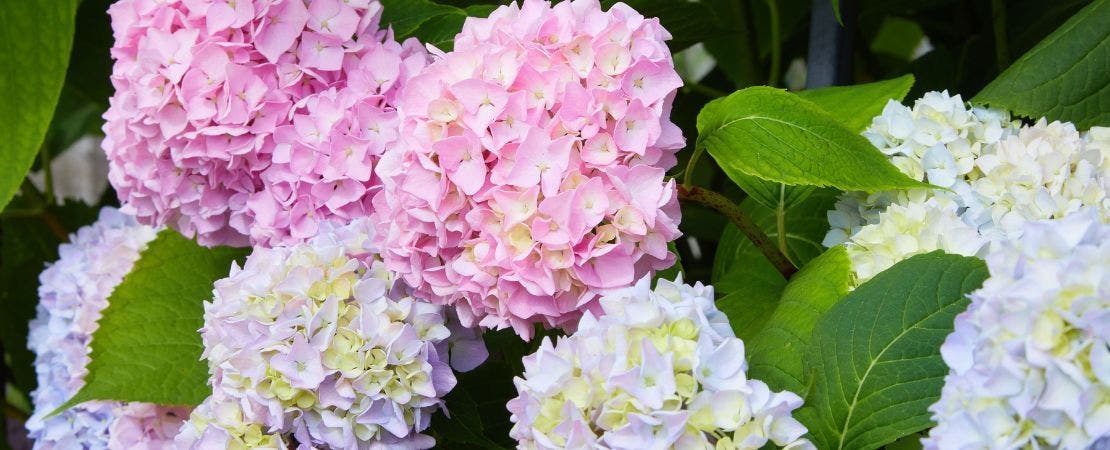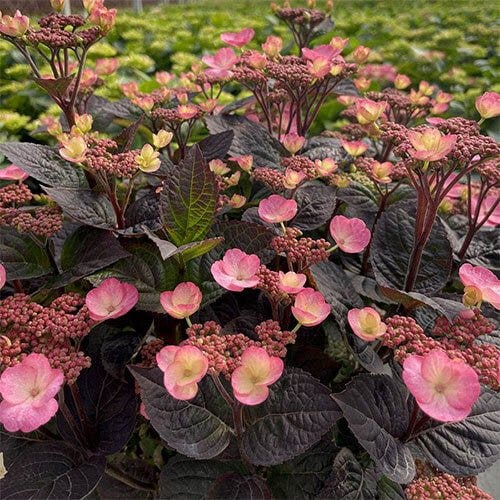Learn More About Hydrangeas, a Gardener's Favorite
For many years now hydrangea bushes have been one of the most popular perennials in American gardens. The variety of these flowering shrubs that is available is quite impressive. Far from being just the one-colored blue hydrangea flower puffballs that you remember from your grandmother’s garden. There are 23 species, but of these, only five are widely available in the US. The five that are available represent a great variety of flowering perennials, with an option that is right for almost any American gardener. 'Annabelle' hydrangea and Limelight hydrangea are names you may be familiar with because they are so popular.
The one that you’re most likely familiar with is the Hydrangea macrophylla (more commonly called bigleaf hydrangea, garden hydrangea, or French hydrangea).
These plants are the most recognizable and produce impressive bounties of flowers. The color of the flowers can be changed from red or pink to white or bright blue by adjusting the chemical content of the soil in which they’re growing.
Panicle Hydragea
Panicle Hydrangeas (Hydrangea paniculata) are the most cold-hardy of the common species. They are the largest type as well, some growing to fifteen feet. These Asian natives are often pruned into tree form and sold as “hydrangea trees.” They bloom in mid-summer, usually with large white flowers on six- to eighteen-inch panicles. In some varieties the white flowers mature to pink.
Two popular types of panicle hydrangeas are Limelight hydrangea with flowers that are a springtime inspired bright green and Bobo hydrangea that's perfect for a patio container. Panicle hydrangea varieites include a range of colors including red, pink, white, and lavender. This type likes a sunny location.
Oakleaf Hydrangea
Oakleaf Hydrangea (Hydrangea quercifolia) There are two hydrangea species that are native to the US. The larger of the two is the oakleaf. Much like the panicle hydrangeas, oakleafs bloom with large white panicles that mature to pink or rose. These flowers come sooner, in early summer, and are smaller, on four- to twelve-inch panicles. They are often grown primarily for their beautiful foliage, which matures to a deep bronze in fall. Oakleafs are the only common types of hydrangeas to produce significant fall color.
The Gatbsy series from Proven Winners® ColorChoice® features popular oakleaf varieties.
Smooth Hydrangea
The smaller American native is the Smooth Hydrangea (Hydrangea arborascens). These can be found in the wild from New York to Florida and are nearly as cold-hardy as panicle hydrangeas. They are much better adapted to warm weather. They grow to four or five feet high. In early to midsummer smooth hydrangeas produce large round clumps of bright white flowers that sometimes mature to a lovely pale green. These shrubs are most often used in mass landscape plantings for a striking effect.
Because this type of hydrangea is native, it's popular for biodiverse gardens. The 'Annabelle' hydrangea is probably the most well-known type of smooth hydrangea. Other gorgeous options include the Invincibelle® and Incrediball® collections that also have hydrangeas in sizes for container and small-space gardens with pink, white, red, lime green, or variegated flowers.
Mountain Hydrangea
Mountain hydrangeas (Hydrangea serrata) are woody, deciduous shrubs that offer year-round interest. Although some cultivars produce mopheads, they typically bloom in delicate lacecap groups of flowers from early summer to fall. The flattened flower clusters change color with the pH of the soil, turning pink in alkaline soil and blue in acid soil. Long-lasting, the flowers make excellent cuts for arrangements, fresh or dried. A valuable food source, the florets feed butterflies and beneficial insects in summer, and the seeds sustain songbirds in late fall. After the first frost, the clusters turn a tan to caramel color but remain attractive. Learn more about drying hydrangea flowers.
The Wayside Garden's collection of moutain hydrangeas--Tiny Tuff Stuff™, Tuff Stuff Ah-Ha® and Dynamo®--is perfectly sized for patio growing due to their smaller mature size but over-sized beauty!






